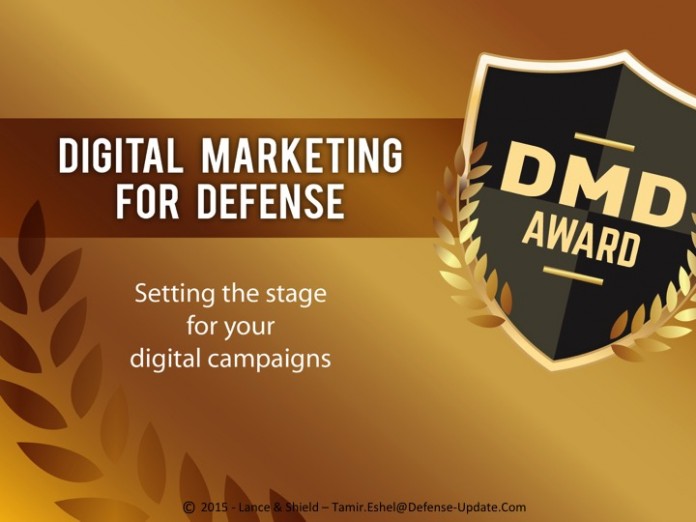As you are reading this blog, you are obviously using digital, online media as part of your daily ‘media diet’. What about your target audience? Are your customers online, and ready to listen? Can you bring them to remember and understand your information correctly?
[ismember]
Setting Expectations
You obviously use email and have a company website, you are definitely part of the ‘digital universe’. So are all your competitors, customers and associates. As part of your close community, most of them know how to reach you and communicate with you online. Therefore, your marketing campaign should touch beyond the ‘believers’ – address and convert a larger audience, currently beyond your reach.
Defense B2B Cycle
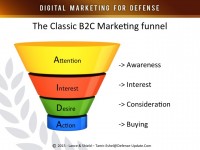 The most common marketing online is the ‘Business to Consumer’ (B2C) process. It is a direct and continuous cycle taking the individual buyer through a complete process seeding awareness, creating interest, desire and leading to action (AIDA). Since advertising can often be attributed as a lead generating the sale, Return on Investment (ROI) of different advertising methods can be measured using lead-tracking methodology.
The most common marketing online is the ‘Business to Consumer’ (B2C) process. It is a direct and continuous cycle taking the individual buyer through a complete process seeding awareness, creating interest, desire and leading to action (AIDA). Since advertising can often be attributed as a lead generating the sale, Return on Investment (ROI) of different advertising methods can be measured using lead-tracking methodology.
The Business-to-Business (B2B) marketing cycle is different, as an AIDA process cannot simply apply to organizations. It also differs in the length and complexity of each segment, each cycle involving both individuals and group players, influencing the process in different stages, as part of a long process that often takes years to mature.
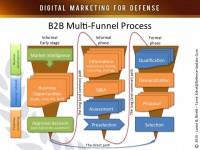 Such a complex processes cannot simply measure ROI to assess the effectiveness of sales support, advertising and promotions, as their long lasting effects are subtle. However, do not dither online advertising just because you cannot measure it.
Such a complex processes cannot simply measure ROI to assess the effectiveness of sales support, advertising and promotions, as their long lasting effects are subtle. However, do not dither online advertising just because you cannot measure it.
It is true that the most significant sales stages are often done in person, through formal and informal discussions, negotiations and demonstrations. But these direct activities are often dependent on not least essential activities, that are ‘shaping the battlefield’ for your sales meetings. These activities also create considerable indirect influence, by keeping decision-makers and their assistants constantly informed. Today, marketers are employing new-media to achieve significant goals; the methods include search engine optimization (SEO), Public Relations (PR), blogging, advertising, social marketing, seminars and exhibitions – all being part of this ongoing campaign.
Part of effective marketing has always been keeping your name at your target audience’s ‘top of mind’. In the past, sending your customers gifts – calendar or paperweights branded with your logo, did this. Advertising in print was used to remind them what your brand stands for, by associating ads with content and events. The design of your ads and the quality of the medium selected for advertising also reflected your strength and values. Ultimately, the customer would also recognize your brand on outdoor billboards and road signs, strategically placed near decision-making locations, and at major exhibitions, thus becoming familiar and increase trust in your brand.
The expansion of digital media opens new opportunities for your marketing. Sponsorship logos, banners placed on selected ‘strategic locations’ or, associated with content, can strengthen your brand with specific audience. New opportunities include content creation for blogs, social networks and video streaming services. Both advertising and content activities should be adapted to all delivery channels – desktop, tablets, mobile devices, apps, emails, video and more.
The first step: Planning
How many people should you target? There are billions online, but the estimated defense-related audience is around 2.5 million, which includes the majority of those using desktop browsers and mobile devices to access commercial defense related websites.
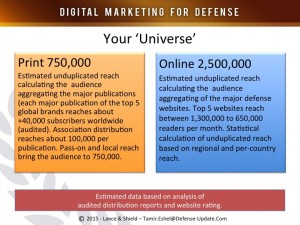
This audience is about 2-3 times larger than the unduplicated audience defense- related B2B magazines are reaching. This larger audience is attributed mainly to the ease of access (most defense websites are not ‘gated’ by passwords) and the immediacy of information (instant updates – compared to daily, weekly or monthly updates by the printed media).
In the past defense professionals were harder to reach online, since web traffic at work was significantly lower than traffic from home. The difference was primarily due to restricted Internet access at the workplace. Today, more employees in all sectors, are including defense, or access the Internet on a daily basis, as they rely on news and reference material for their work. Even if personal computers are blocked from the Internet for security reasons, defense professionals can often access various defense websites, using their own mobile phones and tablets – if not at work, then on their daily transit.
There are more reasons for the recent increase in online audience over printed media. These include public interest by non-professional readers, a growing readership from military service members, as well as unintended ‘hits’ coming from search engines, social networks etc.
How much is ‘enough’?
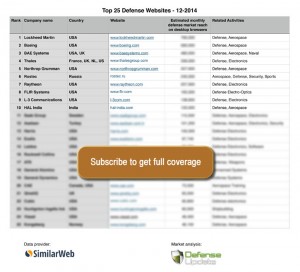
You don’t have to reach this ‘universe’ all by yourself. In fact, except the most popular search engines and portals, no single website is reaching this entire universe. However, there are quite a few websites that are getting close. The ‘Top tier’ names in defense and aerospace are reaching 750,000 – 1,500,000 readers on a monthly basis. You can complement your campaign with more segmented ‘lower tier’ websites, those specialized publications, reaching 500,000 to 150,000 monthly readers, in paving your way to a large, global or regional audience.

Those websites have found their audience with the right formulae of content, frequency and style. Take advantage of their success. Nurture them with interesting and relevant news, photos and videos. Prepare your domain experts to provide commentary, tips and advice. Collect and employ a list of media contacts to deliver your materials, they will use your systems to write their posts, and publish them with your photos and videos that will carry your message through the net.
You’ll be surprised to see a spike in traffic to your website, even if those writers don’t place a link to your site, as it is very simple to Google your website from your company name, especially if it is spelled right. Make sure you have solid tracking of your traffic, and that your website is easy to use, reflecting the subjects you want to promote. Placing contact forms or survey links on those pages will help you collect useful leads from this traffic.
One voice for everyone?
Once you begin to see an interest in your topics, consider promoting them in social networks – LinkedIn is a useful medium to reach professional people in different countries and sectors, including vertical defense markets, aerospace and defense R&D. You can target individual professionals on LinkedIn or join professional groups to spread your messages on a regular basis. You can use a similar process on Facebook. One thing to remember – an experienced journalist carrying your story to market, will be better than your own post on LinkedIn, Google+ or Facebook. A journalist will usually tell the story in a way, that will be more acceptable by the readers, and, once such an article is published, you can promote it on social media in a proactive way.
Not always you have the time, content or interesting stories to leverage social media in an effective way. To overcome this, use advertising as your ‘fire support’. Your advertising toolbox includes text ads, links and banners. Each has its own merit and cost.
Text ads: the most common are Google AdWords, but there are many other text ads available online, on social web, email, video etc. Text ads are simple, readable and can be highly targeted to the user profile, interest and online behavior. Since you often pay for clicks, not ad exposure, you should take advantage of the free publicity you are getting – use an easily recognized product name, designation and purpose; you can even omit your company name from the content line if it is mentioned in the link (URL), as the text ad is likely to be seen hundreds of times by your readers. Since text ads are limited in the number of characters used, they are most useful in promoting specific products, events (invites to seminars, exhibitions). They do not help much in brand building and are not too useful in ‘telling your story’ to your audience.
Links: Another way to associate your products and brand with content is using active links offered by many websites. Active links deliver a message (a text ad or logo) to readers when they ‘hover’ over a link. When they click on this ad, they are transferred to your site and that’s what you pay for. But even when the reader only views the ad without clicking, the graphics and logo leave some impression and that’s the effect they are designed to create. This is your opportunity to associate your company and product with certain subjects, such as your brand (when the reader ‘touches’ the word your logo appears). This could be the name of your company, or subject matter (a link could be the word ‘flight simulator’ for a training company, ’glass cockpit’ for avionics maker, or ‘ejection seat’ for ejection seat specialist, etc.). Overall, active links will help you ‘own’ keywords related to your company or area of expertise. Make sure you don’t overdo this by annoying readers with over exposure.
Banners: While links and words are associated with explicit interests – readers searching for specific subjects – using graphical banner ads through the long cycle of B2B marketing, should be designed to create a lasting impression, rather than direct action (i.e. – beyond the ‘clicks’ they deliver). This is done using attractive design, aligned with your corporate creative strategy to generate interest, raise questions, or substantiate an opportunity.
Banners are perfect for this role, as they are likely to influence your targets when they are relevant to their general interest and occupation – for example, an executive tasked with a market study on lightweight armor solutions will notice a banner on innovative vehicle armor. If they are enthusiastic about their work, they will click on, or it or Google the name of your company or product shown on the banner to get more details. At the same time, viewing the same banner, a colleague studying parachute designs will ignore the banner completely – that’s ‘filtering by design’.
Therefore, your main investment in banner advertising is not what you pay to display the banner, but how you design it. In future posts we will discuss these aspects in more details.
As you rely on the host website to provide the audience to see your banners, focus on banner design and text to attract the interest of your specific audience. Therefore, your placement decisions should focus on the website overall performance such as total audience, geographical reach, as well as the quality, editorial professionalism and style, to strengthen your brand and message.
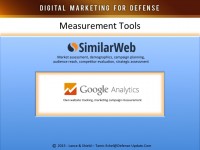 Assessing website audience, you don’t have to trust only what salesmen are selling you. Check the facts on independent rating web services, such as SimilarWeb and Alexa to guide your decision. Another service, Compete is focused mainly on the US market. Ask questions and make educated decisions based on substantiated facts. Through the year the DMD blog will provide a number of regional media studies in different verticals and regions to set some benchmarks to help you start.
Assessing website audience, you don’t have to trust only what salesmen are selling you. Check the facts on independent rating web services, such as SimilarWeb and Alexa to guide your decision. Another service, Compete is focused mainly on the US market. Ask questions and make educated decisions based on substantiated facts. Through the year the DMD blog will provide a number of regional media studies in different verticals and regions to set some benchmarks to help you start.
Once you selected your media mix, you can also target your campaign to gain true ROI for your marketing. Following are few basic methods available online.
Content Targeting: Placing your ads in vertical channels ensures you are seen more frequently by professional readers accessing those sites, although the numbers involved are relatively low.
Sponsorship: Consider associating with specialist websites, or website channels that are fully aligned with your line of activity. Websites offering good quality and affordable price for sponsorship could be attractive for this type of promotion, regardless of the traffic they generate. Nevertheless, publisher statements about the traffic their site generates should be substantiated by website rating, or independent email list audit to protect your investment.
Behavioral targeting: a third method of targeting is behavioral targeting, meaning – reaching readers based on certain aspects of their content use. Major digital advertising agencies and ad networks such as Google AdWords offer these targeting methods. Similar methods can also be employed with certain social media channels.
Remarketing/retargeting: If your privacy policy allows the use of cookies for tracking visitors on your website, you can also employ Retargeting or Remarking, by displaying ads to readers who recently have visited your website, your seminar or landing page recently. Although this method is considered intrusive, it would be quite effective for time-based marketing such as seminars, exhibition invitations or other specific interest topics.
[/ismember]
This tutorial is currently available only to Defense-Update Gold Members. It will be opened to all readers on Wednesday, January 14, 2014. Future tutorials in this series will be available as abstract, with full edition open to our Gold Members. Subscriptions are available for only $7.95 / month.

